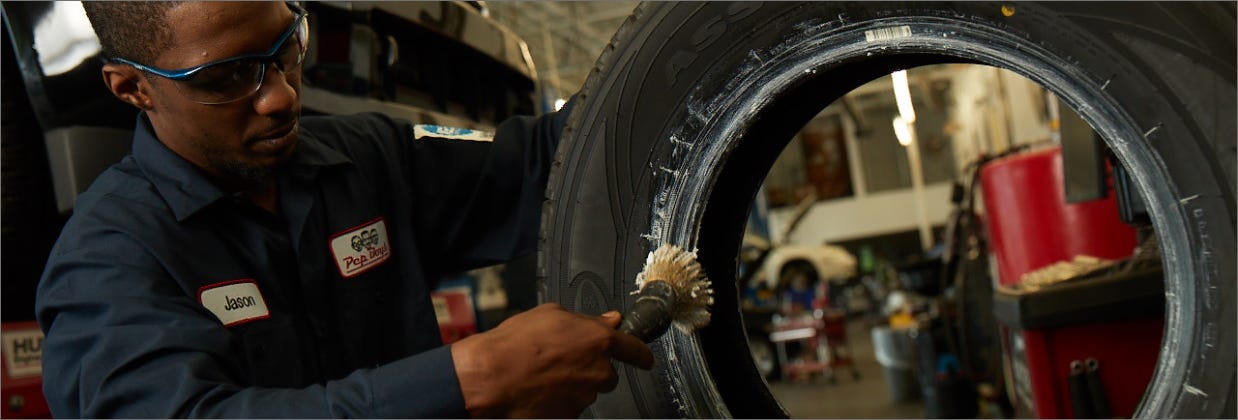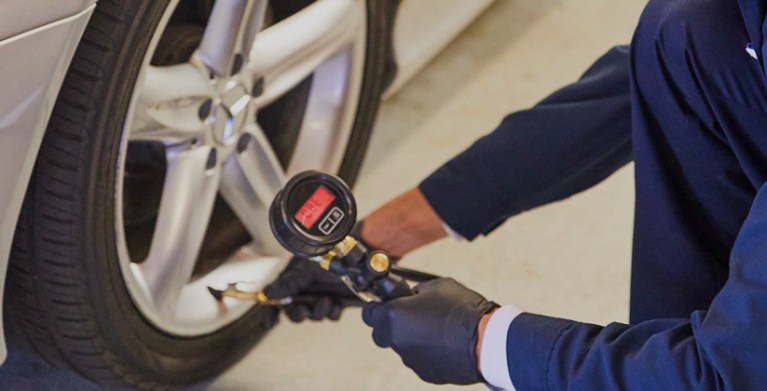The Link In Between Tire Solution and Gas Performance
Amongst the different aspects that influence fuel effectiveness, tire service stands out as a crucial aspect that often goes neglected. The intricate partnership in between tire maintenance and fuel economy is a testimony to the elaborate operations of an automobile.
Significance of Appropriate Tire Inflation
Correct tire rising cost of living is a critical consider making best use of gas efficiency and ensuring optimal automobile performance. When tires are underinflated, it produces extra moving resistance, causing the engine to function harder and burn more gas to preserve the exact same rate. On the various other hand, overinflated tires can bring about a harsher trip, irregular tire wear, and minimized grip. To find the advised tire stress for your vehicle, describe the owner's manual or the sticker label located on the motorist's side door jamb.
Preserving the proper tire stress not just enhances fuel effectiveness but also improves driving safety and security. Routinely examining and changing tire stress, especially before lengthy journeys, is a basic yet reliable method to maximize your automobile's fuel economy and ensure a smooth driving experience.
Effect of Tire Footstep Deepness
Keeping the recommended tire stress is vital for optimal car performance and gas efficiency; in a similar way, the step depth of your tires plays an important duty in ensuring security and grip when driving. Tire step depth directly affects the ability of your tires to grasp the roadway surface, especially in damp or unsafe conditions. As tires put on down, their step depth decreases, impacting their ability to channel water away and keep correct contact with the roadway. The advised minimum walk depth is normally 2/32 of an inch, however, for improved security and efficiency, many experts recommend transforming tires before they reach this factor. Proper tread deepness not only guarantees much better handling and stopping however also adds to fuel performance by lowering moving resistance. Consistently inspecting your tire tread deepness and changing tires when necessary is a basic yet reliable way to advertise both safety and security and gas efficiency when traveling.
Duty of Wheel Placement in Performance
Guaranteeing accurate wheel positioning is crucial for enhancing automobile effectiveness and making the most of gas economy. Proper wheel placement entails readjusting the angles of the wheels to maker requirements, making sure that they are alongside each other and perpendicular to the ground. When wheels are misaligned, it can bring about uneven tire wear, increased rolling resistance, and decreased fuel efficiency.

Furthermore, precise wheel alignment can likewise enhance handling and security, decreasing the quantity of energy required to navigate the lorry (tire shop near me). By minimizing unnecessary friction and drag, correct wheel alignment plays an essential function in enhancing total vehicle efficiency and fuel economic situation. Routine wheel alignment checks and adjustments are important for preserving ideal performance and maximizing gas cost savings
Link In Between Tire Maintenance and MPG
An essential aspect of enhancing gas efficiency in lorries is the maintenance of tires and their straight effect on miles per gallon (MPG) Appropriate tire upkeep plays an important duty in making best use of fuel economic situation. One Resources crucial factor impacting MPG is tire pressure. Underinflated tires increase rolling resistance, creating the engine to work more difficult and shed even more gas. On the various other hand, overinflated tires lower the get in touch with spot with the roadway, resulting in unequal wear and lowered gas efficiency. Routinely examining and maintaining the appropriate tire stress can significantly improve MPG.
Furthermore, tire walk depth additionally affects gas efficiency. Worn-out treads minimize grip, particularly in wet conditions, compeling the engine to exert more power to maintain speed. This enhanced resistance outcomes in greater gas intake. By ensuring tires have adequate tread depth, vehicle drivers can improve both safety and security and gas economic situation.
Basically, proper tire maintenance, consisting of tracking tire pressure and step deepness, is directly linked to achieving optimal MPG. By including normal tire inspections and upkeep right into a vehicle Read More Here care routine, vehicle drivers can not just prolong tire life however likewise enhance fuel efficiency, inevitably conserving money and reducing environmental impact.

Tips for Fuel-Efficient Tire Care
Provided the important partnership between tire upkeep and gas effectiveness, executing effective approaches for optimizing tire care is essential to improving general lorry performance. Rotating tires at suggested periods promotes also tread wear, improving gas effectiveness by making certain all tires contribute just as to lorry performance. By including these fuel-efficient tire care ideas right into a regular upkeep timetable, drivers can take full advantage of fuel effectiveness, minimize operating prices, and prolong the life of their tires.
Conclusion
Finally, correct tire solution plays an essential function in fuel efficiency. Keeping appropriate tire rising cost of living, monitoring step deepness, and ensuring wheel positioning can all add to making the most of miles per gallon. By routinely keeping tires and adhering to fuel-efficient tire my sources treatment suggestions, motorists can enhance their vehicle's performance and decrease gas usage. It is important to focus on tire maintenance to not just save cash on fuel prices yet likewise to advertise general lorry effectiveness.